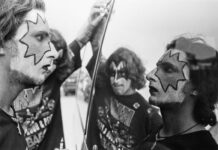~~~
Winthrop Niles Kellogg was a psychologist in the field of behaviorism.
Just like all behaviorists, he believed that man is just an animal defined by external factors and is “programmable” the way we wish to.
But Winthrop held the view that a chimpanzee as well could act like a human, if trained so.
For this reason, he conducted an experiment known as “the ape and the child”.
In 1930, Kellogg “adopted” Gua, a female chimpanzee, at the age of 7 ½ months and reared with his son Donald, who was ten months old at the time.
He was dressing Gua with clothes, putting her to bed, teaching her to eat with a spoon and a fork, talking to her and he was tickling her.
In the beginning everything worked out nicely.
Gua was pretty much like her human brother. She had learned to feed herself, she played with toys for humans and she could grab her nose, if you asked her to do so.
But when Donald became 16 months old (and Gua a little over a year old), some differences between the two species made their appearance: Donald had started to speak, something that Gua – unsurprisingly – was unable to do.
A few months later, Kellogg was forced to terminate the experiment. The reason? Instead Gua acting more like a man, it was Donald who behaved more like a chimpanzee!
Kellogg inadvertently proved that man mimics more than any other animal.
–
“It stands to reason”, I can hear you say, “because a child copies the other’s behavior. This is how it learns”.
The thing is that another experiment proves us that man does not only mimic for learning reasons, but also to “fit” somewhere.
Because as a social being (Aristotle had said that man is a “political animal”), it is too hard to realize themselves as a cast out.
–
The experiment was conducted in 1951 by the American psychologist J.E. Asch.
Asch showed a line to six individuals and asked them to point its equal among three others displayed on another card.
There was no mistaking the right answer since the other two were clearly shorter or longer.
You must be aware by now – by other experiments we have previously described – that the experimenter had set up a conspiracy:
Five out of six “volunteers” were hired by the scientist. They were given directions to choose unanimously a wrong line, showing no doubt whatsoever for their decision.
The five individuals who were in the know would choose first and then, after having heard them, it was the actual subject’s turn to take their pick.
While most of the subjects were seeing that the line chosen by the previous individuals was clearly the wrong answer, they were choosing the same (wrong) line!
If you see the video at the end of the article, you will see for your yourself the internal conflict they go through materializing on ther faces. The subjects know that the line the others pick is definitely the wrong answer, yet they find it hard to go against everyone else. As a result they go with the flow and they decide for the wrong answer, too. Why? Because they play with the rules of the team. And the percentage we speak of? More than 75%.
In a variation of the experiment, Asch directs one of those in the know to choose correctly. In this case, more than 95% of the subjects chose the right answer, too.
The experiment indicates that the subject conform to the unanimity of the team. Yet, if a single person goes for the truth, then the subject musters the courage to stand beside them.
~
What is most inexplicable, and perhaps most important, is that when the subject was informed about the conspiracy, they did not admit that they chose the wrong line because they succumbed to the pressure of the… “public opinion”, but they would rather say that it was their fault, an oversight, a misjudgment.
They would rather believe that they did wrong instead of admitting that their behavior was sheeplike.
–
Asch proved (or at least indicated because, as we have said before, there is no proof in social studies) that man’s spiritual independency is but a myth.
People want more than anything to belong to a group – or, at least, a subgroup.
To achieve this, we are willing to sacrifice any idea we may have that deviates from the norm in order to become likeable to the others.
You must be courageous to tell the truth (whatever you think that the truth is).
When everybody tells you that the line you see is the right one whereas you see that it is the wrong one, it takes courage to stand up for what you believe.
Not only because you might lose your job, but –mainly- because you might find yourself ostracized – by your family, your friends, your fellow-citizens.
If you choose to stand alone, you could be tagged as crazy. That is man’s biggest fear: to stay alone.
Truth, just like freedom, takes virtue and courage.
This is the reason why people with such a high IQ level adopt such wrong views so airily.
It is not stupidity, it is cowardice.
Because man would rather walk with people whose thinking is flawed and come round to their point of view than stay alone by sticking to their own take of things.
It is very difficult, mentally speaking, to stand up against public opinion. And, most of the times, it is also dangerous.
Because the status quo is threatened much more by thinkers than killers.
The only true revolution will come when we start to think freely, without succumbing to the fear of the public opinion because, as Rigas Feraios said: “Only free thinking results in reasonable thinking”.
Let us wrap up this article with the words of a man who stood alone on the mountaintop of his thoughts:
“How much truth could a spirit bear, how much truth could a spirit dare? … that became for me all the more the real measure of value… Error is not blindness; error is cowardice… Every acquisition, every step forward in knowledge is the result of courage and integrity towards our own self”.
Integrity to ourselves. This is how everything we dream of begins.
~~~~~~~~~~~~~~~~~









